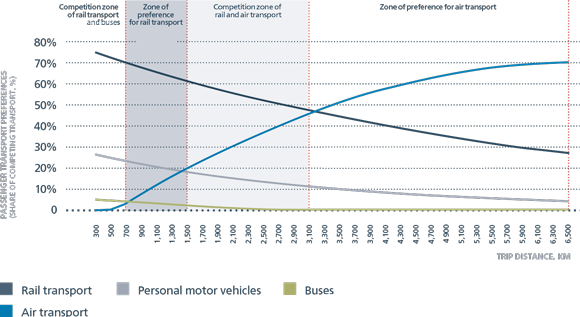Service functions
-
Download center
-
Add to My Report
-
My Report (0)
-
Print this Page
-
Download in PDF
-
Share
-
Feedback
-
Interactive analysis
-
Browsing history
-
Offline version
-
Company in soc.networks
-
Compared to 2011
-
Popular pages
-
Company on the map
-
Compact view
| Enter e-mail recipient * | Your e-mail * | Comment : | |
| * required fields | |||
Internal Passenger Traffic
Air transport is the main competitor of railways in the passenger transportation segment. However, the passenger transportation market remains attractive to JSC “RZD”: we believe that high-speed passenger trains will take share fr om air travel for a number of destinations. The main competitor in the freight transportation segment is road transport, but even here railways have distinct advantages.
Increases in passenger transportation by air have been seen since October 2009. Although only 0,4% of passenger transportation is made by air, its sharein the Russian passenger turnover is significant — 41,3% in 2012, and it grows rapidly: +13,6 p.p. for the last three years.
The growth of passenger turnover by air is the fastest for international journeys, which is due to an increased distance of flights and the number of Russianparticipants serving international destinations: tourist traffic is growing and new tourist destinations are opening.
In 2012, the share of long-distance transportation by air increased by 3.8 p.p. reaching 41.3%, while the rail transport share decreased slightly, by 0.9 p.p. to 30.5%.
This dynamics is caused not only by people’s income growth, but also by flexible fares of airlines and the public policy. Flights from East Siberia and the Far East, as well as lease payments of airlines are subsidized from the federal budget. Moreover, constituents of the Russian Federation receive subsidies to support regional and local transportation by air.
As a result, in the segment of transportation for distances over 1.5 km the share of air transportation is steadily growing at the expense of railways, and the accumulated gap is rather significant for a number the destinations. For example, along the Moscow — Novosibirsk route (2,891 km), the decrease in railwaypassenger turnover over 11 years has fallen to 73.8% with an average fare of a little less than RUR 10.5 th. (in 2011, for a sleeping car), while the share of air transportation has increased from 58% to 89% with a fare of only RUR 7 th. (in 2011, economy class).
According to the Russian Ministry of Transport, rail transport has distinct advantages to passengers for journey distances less than 700 km. Long-distance passenger transportation remains competitive for distances under 1.5 th. km mainly because of the price factor. For distances over 2 th. km, the competitive advantages of rail transportation decrease because of significant travel time.
Public transport passenger turnover in 2012
Number of passengers who used rail transport services in 2012
Passenger transport preferences (share of competing transport, %)

The creation of hub airports to increase transportation volume by
In 2012, the Federal Passenger Company, a subsidiary of JSC “RZD” launched direct trains to Nice and Paris, which increased the passenger traffic on these routes by 2,5 times. Thus, the railways have a fairly good development potential in the international passenger transportation segment as well. With a quality service, railways remain an attractive mode of transportation even in Europe, wh ere aviation and road service are well developed.
 Address of the President
Address of the President
 175th Anniversary of Russian Railways
175th Anniversary of Russian Railways
 Analysis
Analysis
 Save Key Indicators to XLS
Save Key Indicators to XLS
 Transport Development Strategy
Transport Development Strategy
 Investment Activity
Investment Activity
 Download Chapter Financial and Economic Performance
Download Chapter Financial and Economic Performance
 Rating
Rating
 Loan Portfolio
Loan Portfolio
 Management System
Management System
 Governing Structure Of JSC Russian Railways
Governing Structure Of JSC Russian Railways
 Personnel management
Personnel management
 Housing policy
Housing policy